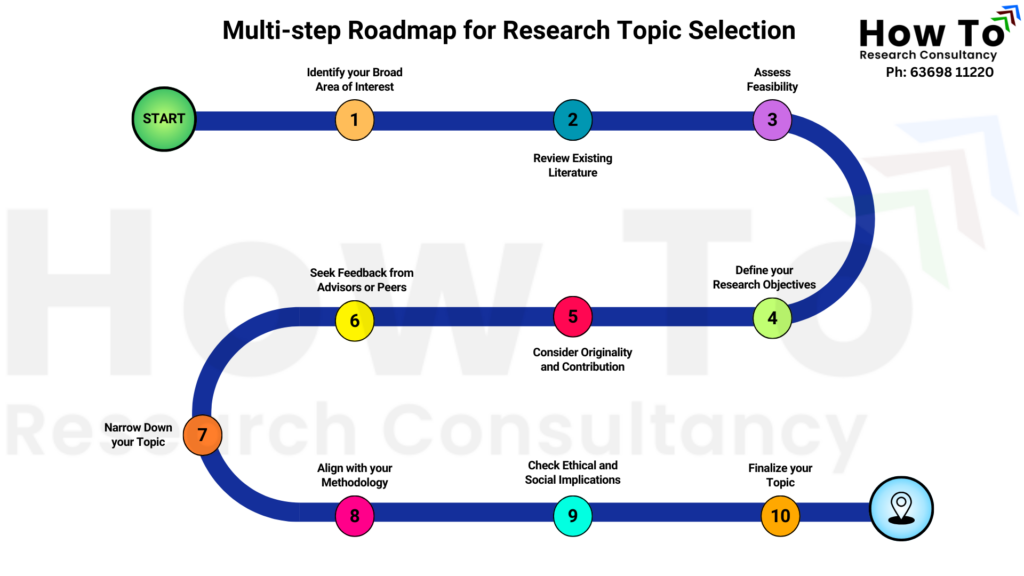Choosing a research topic is a crucial decision in pursuing a PhD or academic article, as it lays the foundation for the study and shapes its direction. A strong topic should align with the researcher’s interests, address gaps in existing knowledge, and be feasible within available time, resources, and expertise. It should also offer potential for future research and practical applications that benefit both academia and industry. This guide provides a step-by-step approach to selecting the perfect research topic with examples across disciplines like HR, Marketing, Finance, Economics, Tourism, Sociology, etc.

1. Identify Your Broad Area of Interest
The first step in selecting a research topic is identifying a broad area that interests you. Think about your academic background, work experience, and what excites you personally. Your topic should align with your future career goals and academic pursuits. Also, choose a topic that is relevant to today’s world and has potential social or industry impact.
Examples:
- In HR, you might be interested in studying how Flexible Working Arrangements influence Employee Productivity and Morale.
- In Marketing, you could explore how Digital Advertising affects Consumer Buying Behaviour, particularly on Social-media.
- In Finance, a good topic could be how Sustainable Investments (like ESG, SRI, etc.) perform in a market, or how Financial Literacy helps in Financial Wellbeing.
- Economics may offer you an opportunity to study how Government Policies impact Small Businesses in rural areas or how Health Promoting Lifestyle improves Life Satisfaction.
- If you are passionate about Tourism, you could research how Eco-tourism affects local communities and their economies.
- In Sociology, you might study how Social-media platforms influence the way young people perceive social issues or political events.
Choosing a topic that connects with real-world challenges, like climate change, digital transformation, or social inequality, will ensure your research has broader significance.
2. Review Existing Literature
Once you have a broad area, the next step is to review the existing research in that field. This helps you understand what has already been studied and where there are gaps that you can address. Use resources like Google Scholar, Scopus, or Research Gate, Semantic Scholar, etc. to look for key papers, important studies, and recent developments in your area.
Pay attention to common themes, recurring findings, and areas that have not been explored fully. If you notice certain topics are well-researched, but some aspects are still missing or underexplored, that is where you can make your contribution.
Example:
If you are studying Corporate Sustainability, you may find that most studies focus on large multinational corporations, while smaller firms or start-ups have not been studied in depth. This gap can become the focus of your research, allowing you to contribute new insights.
3. Assess Feasibility
Before finalizing your topic, it is crucial to assess if it is feasible to research within the time and resources available. Ask yourself whether you have the means to access the data you need, whether you can afford any necessary tools or software, and if you can realistically reach your target audience for data collection.
Examples:
If you want to study “Reducing Carbon Emissions in Manufacturing,” you might need data from specific companies or industry reports, which could be hard to obtain without proper contacts or permissions.
If you are interested in Tourism and want to research “Tourist Satisfaction in Remote Locations,” you might face challenges in reaching participants or traveling to these areas.
Be realistic about potential challenges, such as the availability of data, the time needed, or the ethical considerations related to your study, and plan for them.
4. Define Your Research Objectives
Clear objectives will help you stay focused and guide your study. These objectives should be specific, measurable, achievable, relevant, and time-bound (SMART). They should outline exactly what you want to achieve in your research.
Example:
If your research topic is “The Impact of Digital Advertising on Brand Loyalty” in Marketing, your objectives could be:
Identify the key strategies in digital advertising.
Analyse how these strategies influence customer behaviour (Perception, Satisfaction, etc.).
Measure their effectiveness in building brand loyalty.
Well-defined objectives help you stay on track and make your research more organized and focused.
5. Consider Originality and Contribution
It’s essential that your research adds something new to the field. This could be a fresh perspective, an underexplored topic, or new ways to approach old problems. Aim to address gaps in the literature that have not yet been fully explored.
Example:
While sustainability is a popular topic, few studies have looked at the role of Artificial Intelligence (AI) in improving Sustainability Practices in Small and Medium Enterprises (SMEs). This could be a unique and valuable research area.
Your research should offer new insights that contribute to your field, whether it is academic knowledge or practical advice for businesses or policymakers.
6. Seek Feedback from Advisors or Peers
Before settling on your topic, seek feedback from research supervisor/guide, professors, mentors, or peers. They can provide useful insights, point out potential weaknesses, or suggest areas that need more attention. This feedback will help you refine your topic and ensure it meets academic standards.
Example:
If your topic is “Digital Transformation in Retail,” your advisor might suggest narrowing it down to something more specific, like “The Role of Digital Payment Systems in Improving Customer Experience in Urban Retail Stores.” This makes your topic more manageable and focused.
Feedback helps strengthen your topic and ensures it aligns with academic or professional expectations.
7. Narrow Down Your Topic
Once you have gathered feedback and reviewed your research objectives, it is crucial to narrow down your topic to ensure it is specific and manageable. A well-focused topic should address a single research question or hypothesis, making the study clear and achievable. For example, if your original idea was “Sustainability in the Food Industry,” you could narrow it down to “Examining the Effectiveness of Waste Management Practices in Reducing Carbon Emissions in Food Processing SMEs.” This refined focus ensures that your research remains clear and relevant.
In addition to narrowing your topic, it is essential to define the variables that will guide your research. These variables typically include independent variables (IV), dependent variables (DV), and any moderating or mediating variables that may influence the relationship between them. For instance, in a study on “The Effectiveness of Waste Management Practices in Reducing Carbon Emissions,” the independent variable (IV) could be “Waste Management Practices,” the dependent variable (DV) might be “Carbon Emissions,” and a moderating variable could be “Company Size.” A mediating variable, such as “Employee Awareness of Sustainability,” could also be included if it affects how waste management practices influence emissions. Defining and narrowing your topic with these variables in mind ensures a focused and structured approach to your research, making it both manageable and meaningful.
8. Align with Your Methodology
When selecting a research topic, it is important to ensure that it aligns with the research methodology you plan to use. Whether you are conducting qualitative, quantitative, or mixed methods research, your topic should be suited to the approach you choose. Qualitative methods typically involve interviews, focus groups, or case studies to explore deeper insights and subjective experiences, while quantitative methods use surveys, statistical analysis, or experiments to quantify data and test hypotheses. Mixed methods combine both approaches for a more comprehensive understanding.
For example, if your topic is “Customer Satisfaction with Eco-friendly Packaging” in Marketing, you could adopt a mixed-methods approach. You might conduct surveys to gather numerical data on customer preferences and satisfaction levels and use interviews to understand the deeper reasons behind their attitudes toward eco-friendly packaging.
In addition to these, you may also choose exploratory or cross-sectional research designs based on your research goals.
Exploratory research design is often used when there is limited prior knowledge about a topic. It helps researchers investigate new phenomena, identify variables, and generate hypotheses. For instance, if you’re exploring “Consumer Perceptions of Electric Vehicles in Emerging Markets,” an exploratory design could help uncover factors influencing perceptions before further in-depth research.
Cross-sectional research design involves collecting data at a single point in time and is typically used to assess relationships between variables within a specific population. For instance, if you study “Employee Job Satisfaction in Automobile and Insurance Industry,” a cross-sectional design can help you compare satisfaction level across these two industries at once.
Aligning your topic with the correct methodology ensures that your study can be effectively executed and that your findings will be meaningful and valid.
9. Check Ethical and Social Implications
All research must follow ethical guidelines and consider the social implications of its findings. Researchers should be aware of whether their study involves sensitive topics or vulnerable groups, and take necessary precautions to ensure participants’ privacy and consent. For example, when researching topics like “Consumer Privacy Concerns in E-commerce” or “The Impact of Digital Advertising on Children Behaviour,” it is important to protect participants’ identities and secure informed consent, especially when dealing with minors or sensitive data.
Additionally, researchers should reflect on how their work can positively influence society. Research on topics like “Healthcare Access in Rural Areas” can provide valuable insights for improving healthcare infrastructure, while studies on “Sustainable Business Practices in the Fashion Industry” can promote environmental responsibility. Ensuring that research is ethically sound and socially beneficial enhances its relevance and impact, ultimately contributing to the well-being of individuals and society.
10. Finalize Your Topic
After considering all aspects, finalize your topic. Ensure it is clear, concise, and directly reflects your research objectives. A well-defined topic is key to your study’s success and will provide you with a clear direction for the rest of your research.
Example:
Your finalized topic might be “The influence of Digital Advertising on Brand Satisfaction and Loyalty with respect to Eco-friendly Products among Millennials in Chennai,” which is focused, relevant, and manageable.
Finalizing your topic gives you the confidence to proceed with your research and lays a solid foundation for the entire study.
Steps for selection of research topic with practical example
Identify Your Broad Area of Interest – Fintech Services in Mumbai City
Review Existing Literature – Explore existing research to understand current knowledge and gaps on Fintech Services.
Assess Feasibility – Ensure that resources, data, and access to millennials in Mumbai are available, while also considering time constraints and study requirements to confirm the project’s feasibility.
Define Your Research Objectives – Set clear, measurable goals, such as understanding how Fintech services impact user experience and engagement among millennials in Mumbai.
Consider Originality and Contribution – Ensure your research adds value by exploring the unique relationship between Fintech services and millennial users in Mumbai and offer new insights that have not been explored in existing studies.
Seek Feedback from Advisors or Peers – Share your research idea with mentors or peers for valuable input and suggestions to refine the topic.
Narrow Down Your Topic – Focus the topic further, such as studying specific Fintech services like mobile banking or online payments for millennials in Mumbai.
Align with Your Methodology – Choose appropriate research methods (e.g., surveys for quantitative data, interviews for qualitative insights) to gather relevant data.
Check Ethical and Social Implications – Address ethical concerns, such as participant privacy and financial data protection. Consider how the research can positively impact society, such as improving financial inclusion for millennials.
Finalize Your Topic – Ensure the topic is clear, manageable, and feasible for study. After refining the focus, the research title can be finalized:
“Exploring the Impact of Fintech Payment Services on User Experience and Engagement Among Millennials in Mumbai City.”
Conclusion
Choosing the right research topic is a critical step that sets the stage for your PhD or academic research. By following these simple steps, i.e., identifying your area of interest, reviewing the literature, assessing feasibility, defining objectives, ensuring originality, and seeking feedback, you can select a topic that is focused, feasible, and meaningful. A well-chosen topic will help you stay on track throughout your research journey and contribute valuable knowledge to your field.
Call to Action
Ready to refine your research topic and methodology for impactful results? Contact us for a personalized consultation to guide you through the process!









Leave a Reply